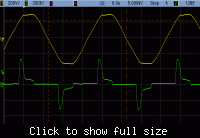eem2am
Banned
cfl bulb ratings
Hello,
I have a 15W CFL and looked at the current entering this bulb from the mains (i used a 12W resistor in series with the 'hot' line and looked across it with the scope)
Mains is 240V , 50Hz
The current came out as 59mA RMS, giving an input power of 14.2W.
I would have expected, with inefficiency, for the power input to be more like 18 Watts.
Do you think they have over-rated this bulb's power rating ?
..here is the bulbs input current....

Hello,
I have a 15W CFL and looked at the current entering this bulb from the mains (i used a 12W resistor in series with the 'hot' line and looked across it with the scope)
Mains is 240V , 50Hz
The current came out as 59mA RMS, giving an input power of 14.2W.
I would have expected, with inefficiency, for the power input to be more like 18 Watts.
Do you think they have over-rated this bulb's power rating ?
..here is the bulbs input current....


